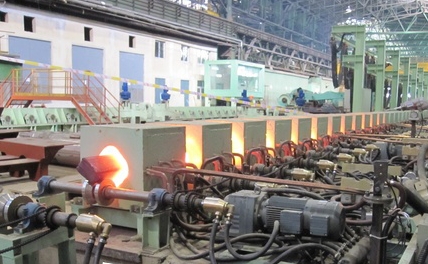- 15
- Feb
Computer control system requirements for steel pipe temperature raising induction heating equipment
Computer control system requirements for steel pipe temperature raising индукциона грејна опрема:
1. Self-learning control mode to complete the self-tuning of parameters:
First call the process recipe template to set the power, and then use the self-learning control method to complete the self-tuning of the parameters, and finally meet the control requirements of the system. After the steel pipe is heated, the temperature reaches 1100°C.
2. Use reliable and optimized control algorithms to achieve temperature closed-loop control:
The production line adopts PLC automatic temperature control, equipped with three infrared thermometers, and the detection temperature is the middle of the two sets of equipment, and the entrance and exit of the entire production line.
The first infrared thermometer at the entrance of the furnace body detects the initial temperature of the steel pipe before it enters the heating furnace, and feeds it back to the temperature control system of the first set of equipment, so that the output power meets the requirement of 60% of the final temperature of the steel pipe (according to actual Setting), a second infrared thermometer is installed at the outlet of the furnace body of the first set of equipment and the inlet of the induction furnace body of the second set of equipment to detect the temperature difference between the real-time temperature of the steel pipe and the target temperature, and then transmit it to the PLC control The output power of the two sets of equipment makes the temperature of the online steel pipe reach the set process temperature.
The third infrared thermometer set in the induction furnace displays the final temperature of the steel pipe in real time, and feeds back the temperature difference of the target temperature to the PLC to control the basic power of the two sets of equipment to fine-tune the difference due to objective reasons such as room temperature, season, environment, etc. The temperature change caused. Use reliable and optimized control algorithms to achieve temperature closed-loop control.
3. Process setting, operation, alarm, real-time trend, historical record screen display requirements:
1. Dynamic tracking display of steel pipe running position.
2. The temperature of the steel pipe before and after heating, the graphs, bar graphs, real-time curves and historical curves of the voltage, current, power, frequency and other parameters of each intermediate frequency power supply.
3. The display of the set values of steel pipe heating temperature, steel pipe diameter, wall thickness, conveying speed, power supply power, etc., as well as the call and storage of the process recipe template screen.
4. Overload, overcurrent, overvoltage, lack of phase, undervoltage of control power supply, low cooling water pressure, high cooling water temperature, low water flow, stuck pipe and other fault monitoring display and record storage.
5. Report printing, including steel pipe heating system table, fault history record table, etc.
4. Process formulation management:
Products of different specifications, materials, and temperature rise curves should have corresponding process recipe templates (which can be gradually finalized in the actual production process). The set values and process control PID parameters can be modified in the template, and the modified formula can be saved.
5. Hierarchical management of operators
System administrator, production supervisor, and operator log in at three levels.

